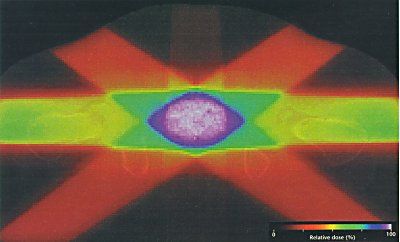Peregrine Provides 3D Monte-Carlo-Based Dose Calculations for Radiation Therapy
The image shows the radiation therapy treatment plan for a seven-field conformal boost to the prostate, using Peregrine, a 3D Monte-Carlo-based dose calculation system. Monte Carlo simulates the trillions of radiation particles that enter the body during treatment and develops a detailed computerized map of the radiation dose the patient will receive. The technology, developed at the Lawrence Livermore National Laboratory and licensed to NOMOS Corporation, has received FDA clearance for marketing. Image courtesy of NOMOS and the Lawrence Livermore National Laboratory, Livermore, California.

The image shows the radiation therapy treatment plan for a seven-field conformal boost to the prostate, using Peregrine, a 3D Monte-Carlo-based dose calculation system. Monte Carlo simulates the trillions of radiation particles that enter the body during treatment and develops a detailed computerized map of the radiation dose the patient will receive. The technology, developed at the Lawrence Livermore National Laboratory and licensed to NOMOS Corporation, has received FDA clearance for marketing. Image courtesy of NOMOS and the Lawrence Livermore National Laboratory, Livermore, California.